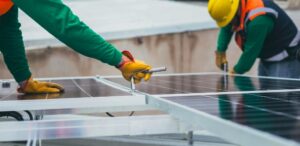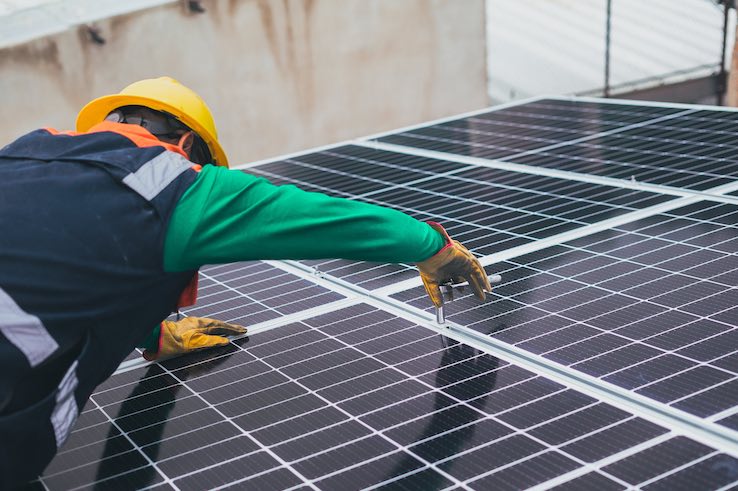Last updated on December 13th, 2023 at 11:54 am
As people get more environmentally conscious and the price of energy rises, more and more homeowners are turning to solar power. Solar panels are a great way to generate your own energy and reduce dependence on the grid.
Throughout 2023, between 341 and 402 GW of solar will be installed worldwide. This huge shift towards solar energy can be intimidating to homeowners who have no idea where to start. To clear up some of your questions, this guide explains how much solar panels cost to install in 2024.
How Much Do Different Sizes of Solar Panels Cost to Install?
The size of the solar panel system is a significant factor influencing installation costs, ranging from around £7815 for smaller systems to upwards of £13000. Larger systems generally come with higher upfront expenses but may offer greater long-term savings.
| System Size | Estimated Costs | Number of Panels | Roof Space | House Size | Costs to Install |
| 3kW | £7,815 | 12 | 22m2 | One-bedroom flat or small house | £5,000 – £6,000 |
| 4kW | £10,420 | 16 | 29m2 | 1-2 bedroom house | £6,000 – £8,000 |
| 5kW | £11,305 | 20 | 32m2 | 3 bedroom house | £8,000 – £9,000 |
| 6kW | £13,566 | 24 | 43m2 | 4-5 bedroom house | £9,000 – £11,000 |
Figures are based on 250W panels, average household energy consumption, Octopus Energy’s SEG tariff, and electricity prices as of October 2023. Actual costs may vary.
What Impacts the Cost of Solar Panel Installation in 2024?
| Factors | Impact on Installation Costs |
| System Size | Larger systems generally cost more to install. |
| Type of Panels | Monocrystalline panels are more efficient but costlier than polycrystalline panels. |
| Installation Process | DIY installation may save on labor costs, but professional certification is needed for benefits like the Smart Export Guarantee. |
| Additional Components | Installing extra components may increase equipment costs but could reduce installation costs. |
| Location and Labour Costs | Labour costs vary based on location, affecting overall installation expenses. |
Which Types of Solar Panels Cost Less to Install?
The choice between monocrystalline, polycrystalline, and thin-film solar panels can impact overall costs of the solar system, but they don’t always impact the cost of installation. If you are factoring the cost of the panels into your installation cost, here is a breakdown of how each type affects your total spend:
| Solar Panel Type | Efficiency | Cost per Watt Range |
| Monocrystalline | High | £1.00 – £1.50 |
| Polycrystalline | Moderate | £0.90 – £1.00 |
| Thin-film | Variable | Variable |
Will It Cost Less to Do My Solar Panel Installation Myself?
Yes, but this might not end up being worth it in the long run. DIY installation may save on labor costs, but professional certification is needed for you to get benefits like the Smart Export Guarantee (SEG). Hiring a professional ensures proper certification and adherence to regulations.

Do Solar Batteries Affect Solar Panel Installation Costs?
Adding a solar battery storage system increases the overall costs of your solar panel investment. However, it offers the advantage of using stored electricity when the sun is not shining, and doesn’t typically impact the installation costs.
Solar battery storage prices range between £1,200 and £6,000, depending on factors such as battery type, lifespan, and quality. However, you do not typically pay for installation costs.
How Much Do I Pay In Labour Costs For Solar Panel Installation?
Labour costs are a crucial component of solar panel installation. They are influenced by location and hourly rates. Typically ranging from £300-£500 per person per day, these costs can vary based on the area in the UK. Two common methods are used for calculating these costs:
Since solar panel installations typically require two people, the final installation fee can range from £600 to £1,000. For larger systems, costs may increase if the installation takes more than one day.
| Days to install | Labour Cost |
| 1 | £600 |
| 2 | £1200 |
| 3 | £1800 |
Estimations based on 2 installers working at £300 per day.
How Does Your Property Affect Solar Panel Installation Costs?
Several property-specific factors can impact the overall cost and feasibility of solar panel installation. While you cannot control the size or characteristics of your home, these factors can be a good way to guess how much you will end up paying.
Property Size
The size of your property directly correlates with energy consumption. Larger properties tend to use more energy, meaning you will need larger systems and, consequently, higher installation costs.
Roof Direction
The orientation of your roof significantly influences how efficiently your panels generate electricity. Roofs facing south, south-west, and south-east are considered highly efficient, while north-facing roofs may experience lower efficiency.
Roof Characteristics
The access, strength, and angling of your roof impact the ease of installation. Factors such as the strength of the roof and the angling of the panels contribute to the overall complexity of the installation process, potentially affecting labor costs.
How Can I Save on Solar Panel Installation Costs?
Find the Right Sized System
Conduct a thorough analysis of your energy consumption. Only purchase a solar panel system that’s big enough to meet your home’s needs. This ensures you invest in a capacity that matches your actual energy usage, avoiding unnecessary expenses.
Explore Government Incentives
Take advantage of government incentives and grants available for solar panel installations. In the UK, schemes like the Smart Export Guarantee (SEG) offer financial rewards for exporting surplus energy to the grid.
Panel Type and Efficiency
While monocrystalline panels are more efficient, polycrystalline panels provide a cost-effective alternative. Find a good balance between efficiency with cost to find the right solution for your budget.
Consider DIY Installation
If you have the skills and confidence, consider a DIY installation. While this may not be suitable for everyone, it can significantly reduce labor costs. However, this is only something to consider if you are really sure you have the skills and qualifications.
Bundle Additional Components
If you plan to install additional components such as solar batteries or pigeon-proofing features, consider bundling them with the initial installation. This can reduce equipment costs and potentially decrease installation expenses.
Roof Characteristics
Choose a location with optimal sunlight exposure and ensure your roof is suitable for solar panel installation. Roofs facing south, south-west, or south-east are considered highly efficient, potentially reducing installation complexities and costs.
Get Multiple Quotes
Shop around and obtain quotes from multiple local installers, or work with a service like Warmable that searches the market for the best quotes. This allows you to compare prices and choose a competitive option.
Self-Consumption
Use energy-intensive appliances during daylight hours when your solar panels are active. This improves self-consumption and reduces reliance on grid electricity, contributing to greater overall savings.
Solar Panel Financing
Explore financing options to ease the upfront financial burden. Some providers offer financing solutions that allow you to pay for your solar panel system over time, making it more accessible.
Regular Maintenance and Cleaning
Maintaining and cleaning your solar panels regularly ensures optimal performance. Efficient panels generate more electricity, making more savings over time. You can use a service like Warmable to connect you with a trusted local engineer who can carry out your maintenance visits.


